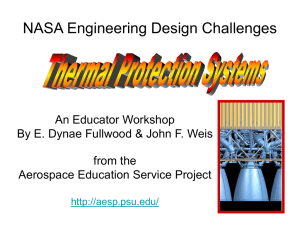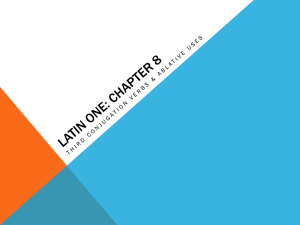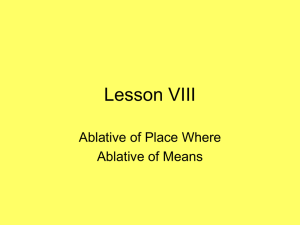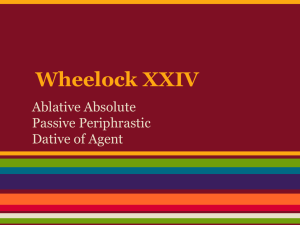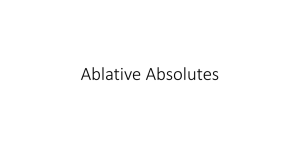FP7/SPACE PROJECT ``HYDRA`
advertisement
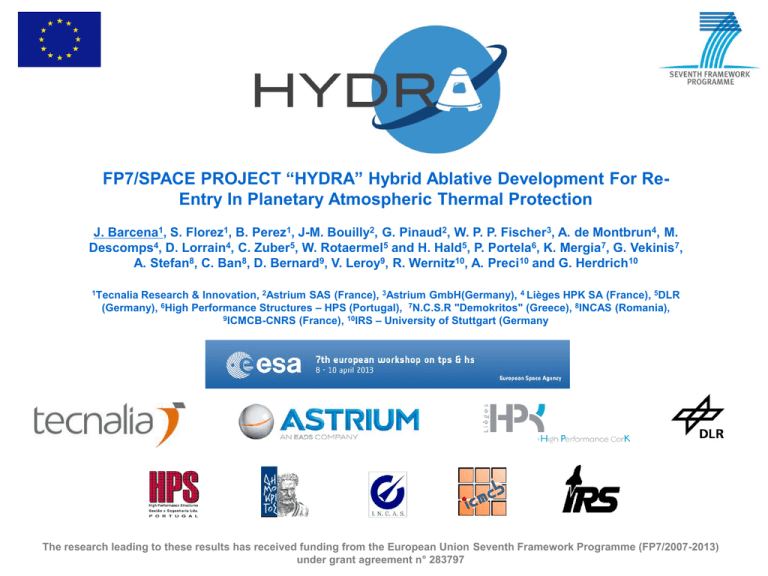
FP7/SPACE PROJECT “HYDRA” Hybrid Ablative Development For ReEntry In Planetary Atmospheric Thermal Protection J. Barcena1, S. Florez1, B. Perez1, J-M. Bouilly2, G. Pinaud2, W. P. P. Fischer3, A. de Montbrun4, M. Descomps4, D. Lorrain4, C. Zuber5, W. Rotaermel5 and H. Hald5, P. Portela6, K. Mergia7, G. Vekinis7, A. Stefan8, C. Ban8, D. Bernard9, V. Leroy9, R. Wernitz10, A. Preci10 and G. Herdrich10 1Tecnalia Research & Innovation, 2Astrium SAS (France), 3Astrium GmbH(Germany), 4 Lièges HPK SA (France), 5DLR (Germany), 6High Performance Structures – HPS (Portugal), 7N.C.S.R "Demokritos" (Greece), 8INCAS (Romania), 9ICMCB-CNRS (France), 10IRS – University of Stuttgart (Germany The research leading to these results has received funding from the European Union Seventh Framework Programme (FP7/2007-2013) under grant agreement n° 283797 OUTLINE INTRODUCTION AND MOTIVATION CONCEPT OF THE PROJECT CONSORTIUM, SCHEDULE AND WPs LOGIC MISSION REVIEW AND TPS SPECIFICATIONS MATERIALS STATE OF THE ART AND TRADE-OFF MATERIALS SELECTION AND PROCUREMENT BONDING & TPS ASSEMBLY SIMULATION AND TPS DESIGN CHARACTERISATION & VERIFICATION PLAN SUMARY AND MAIN CONCLUSIONS ACKNOWNLEDMENTS 08-04-2013 / 2 INTRODUCTION AND MOTIVATION 08-04-2013 / 3 Original approaches based on ablative materials and novel TPS solutions are required for space applications where resistance in extreme oxidative environments and high temperatures are required. The atmospheric entry of space vehicles from high-energy trajectories requires high-performance thermal protection systems that can withstand extreme heat loads. A new scenario has appeared due to a worldwide change in space mission planning strategies with entry vehicles going back to capsule designs and ablators are re-gaining attention. Consequently, the development of new, more efficient materials and systems is a must. Such developments, nevertheless, have to be subject to extensive experimental investigations using suitable facilities. In this view, the investigation and development of new materials based on ablative and thermostructural concepts is crucial. A new (hybrid) concept based on the combination of both type of TPS materials is proposed. The advantage of the ceramic for this function is the low density compared to ablative material and the excellent thermal performance in this heat load range, as well as the stability of the shape of TPS which is an advantage for the aerodynamic of the re-entry vehicle. Another asset comes from the reliability and safety point of view. The underneath ceramic core offers extra thermal protection in case of the failure or underestimated design of the ablative external protections (see reference of the Galieo’s Probe). An accompanying effect is also the lower contamination during all mission phases and especially during re-entry. CONCEPT OF THE PROJECT 08-04-2013 / 4 The concept of the project is based on the development of a novel hybrid heatshield, based on the integration of an external ablative parts with a CMC thermostructural core. This will be carried out by the integration of dissimilar materials. The main advantage of a hybrid TPS heat-shield is based on the capability of the ablative layer of the hybrid TPS of bearing higher heat loads than the ceramic layer underneath. Ablative external shield Joining region & Interface CMC core The main challenge is to achieve a sound bonding among the two parts. This will be carried-out by advanced bonding technologies. This will be carried out by the study and development of new adhesives solutions, with improved mechanical and insulating characteristics. The use of advanced high temperature adhesives and hybrid solutions in combination with mechanical attachments will be assessed, as well as other existing hybrid solutions. CONCEPT OF THE PROJECT Ablative based re-entry 08-04-2013 / 5 CMC based re-entry Heatflux Heatfluxpeak, Interfacetemp, limit 1200 ºC T (sec) Timeablative full burn-out From this point of view it will offer improved mechanical properties as well as higher robustness during the entry. Besides, the new moon or interplanetary missions planned cause higher heat loads during earth re-entry than ceramic or metallic TPS can withstand, since these heat loads are characterized by a peak profile the ablator can bear the high heat loads during the peak. For that a comparatively thin layer of ablative material is sufficient. The large integral loads will then be overtaken by the ablative/ceramic interfacial layer. CONSORTIUM 08-04-2013 / 6 CONSORTIUM MEMBERS LOCATION The core group of HYDRA project is composed of 10 public and private organisations coming from 5 different European countries: France, Greece, Germany, Romania and Spain. 2 – ASTRIUM-G 5 – DLR 8 – INCAS 3 – ASTRIUM-F 1 - TECNALIA (Coordinator) 10 – IRS 6 – HPS 4 – HPK 9 – ICMCB 7 – DEMOKRITOS CONSORTIUM Part.No. Part. Short Name 08-04-2013 / 7 Profile Relevant expertise for the project Role in the project Coordination, materials developer, materials joining, centre in charge of dissemination actions. 1 TECNALIA Research centre Ceramic composite materials design, processing, bonding terisation. Background on disseminations and technology transfer. 2 ASTRIUM-G End user, large company, large system integrator CMC material development, design, analysis, manufacturing & flight/ground testing as well as application Developing, designing, manufacturing and characterization testing of C/SiC CMC's. Mission specification, Material developer and producer, heatshield analysis WPs Involvement WP2, WP5, WP8, WP9. Technical coordination in (WP1, WP3, WP4, WP6, Wp7) WP4, WP8 3 ASTRIUM-F End user, large company Knowledge of management of atmospheric entry programs. Competence in heatshield thermal protection materials : development, production, characterisation, modelling and analysis 4 HPK SME, material supplier Cork composite materials (formulations and manufacturing), tooling, bonding, moulding and prototyping Ablative cork materials and TPS breadboard part supplier. WP3, WP8 5 DLR Research centre, space systems manufacturer, DLR is the German space agency. CMC material development and charactersiation Developing, designing, manufacturing and characterization testing of C/CSiC CMC's. Characterisation of hybrid joints. WP4, WP5, WP6, WP7, WP8 6 HPS SME, technology provider TPS technology provider. Konow-how on materials selection. Technology advisory. Engineering consulting. WP2, WP5, WP6, WP7, WP8 7 NCSRD Research centre Ablative-ceramic joining. Ceramic composite materials characterization & coatings. Materials joining and characterization. WP3, WP4, WP5, WP7, WP8. Characterisation of space materials WP1, WP3, WP6, WP8 8 INCAS Research centre Composite materials CFRP, C-C composite and partially ceramic matrix design, processing, thermo-mechanical characterisation and morfostructural investigation 9 ICMCB Research centre Numerical modeling of coupled phenomenon occurring at local scale, 3D imaging of multi materials Modelling and characterisation WP6, WP7, WP8 10 IRS University Characterisation of TPS comments and hot structures. Ground re-entry characterisation and validation of the technology sample WP1, WP7, WP8 WP7, WP8 WORKPACKAGE: STUDY LOGIC 08-04-2013 / 8 WP1 Mission Profile & TPS specs WP2 WP4 Structural Ceramic Core WP5 Full TPS assembly WP6 Modeling, Simulation and Design WP7 Charac., Re-entry test & Validation RTD MANAGEMENT OTHER WP9 WP8 WP3 Ablative Protection Shield Financial Management Use, Explotaition & Dissemination SoA & Materials Trade-off SCHEDULE STATUS February 2015 January 2015 December 2014 November 2014 October 2014 September 2014 August 2014 July 2014 June 2014 May 2014 April 2014 March 2014 February 2014 January 2014 December 2013 November 2013 October 2013 Year 3 September 2013 August 2013 July 2013 June 2013 May 2013 April 2013 March 2013 February 2013 January 2013 December 2012 November 2012 October 2012 Year 2 September 2012 August 2012 July 2012 June 2012 May 2012 April 2012 March 2012 WP No. WP1 Mission review, trade-off, selection and TPS specs WP1.1 Mission Profile WP1.2 TPS specifications WP2 State-of-the-art & Materials trade-off WP2.1 State-of-the-art WP2.2 Materials trade-off WP3 Ablative protection shield WP3.1 Advanced ablative materials based on resins WP3.2 Advanced ablative materials based on cork WP3.3 Manufacture of heat-shield parts WP4 Stuctural ceramic core WP4.1 Ceramic core development & characterization WP4.2 Ceramic core concept verification & demonst. WP5 Full protection system assembly WP5.1 Definition of bonding processes WP5.2 Ablative/ceramic frames joining WP5.3 Fabrication of TPS breadboard WP5.4. Testing & characterisation of the joint WP6 Modelling, simulation & TPS design WP6.1 Simulation of the oxidation WP6.2 Hybrid thermal modelling of the hybrid concept WP6.3 TPS final design WP7 Characterisation, re-entry and validation WP7.1 Microstructural and Thermo-mechanical chara. WP7.2 Re-entry testing WP7.3 Validation of the envisaged TPS concept WP8 Use, exploitation and dissemination WP8.1 Dissemination activities plan WP8.2 Use plan WP9 Financial management, coord. and reporting WP9.1 Administrative WP9.2 Financial February 2012 Year 1 08-04-2013 / 9 M1 M2 M3 M4 M5 M6 M7 M8 Status at M13 MATERIALS TESTING & CHARACTERISATION PLAN MANUFACTURE WP3 & WP4 AST-F Manufacture of 10 ASTERM plates (550 x 550 x 70 mm) HPK Manufacture of 10 NORCOAT LIEGES plates (550 x 550 x 70 mm) AST-G Manufacture of SICARBON samples 1 m2 in different pannels, 5mm DLR Manufacture of CC/SiC samples 1 m2 in different pannels, 5mm ASSEMBLY WP5 NCRSD Additional testing & surface treatments (K. Mergia) Ablative-ablative interfaces (G. Veknis) 08-04-2013 / 10 CHARACTERISATION WP7 ICMCB - Thermal Characterisation: Only ablators Laser Flash (RT - 1100) Linear Dilatometry (RT-1600 ºC). (No. samples & Dimension TBD) NCRSD Neutron Tomography 20 samples, Ø 40 x 40 mm aprox (special assembly). Before and after PWT TECNALIA •Materials machining •Basic Thermal & Mechanical Characterisation •Gluing & Joining • Materials & Breadboard store HPK “in-situ” Cork Composite manufacture on top of a CMC plate INCAS – Thermo-mechanical: Compression & Flexural (RT) Thermal shock QST2 (RT-1500 ºC) Microstructural study < 75 samples & 30 x 50 x 10 mm DLR Thermo-mechanical at INDUTHERM facility (RT-2000ºC) X-Ray tomography 45 sa mples - 60x 60 x 60 IRS Plasma Wind Tunnel. 20 samples, Ø 39.8 x 40 mm aprox (special assembly) Emissivity (few samples are possible) MISSION REVIEW AND TPS SPECIFICATIONS 08-04-2013 / 11 Mission review and trade-off (by Astrium SAS): analysis of the current mission and European roadmaps for planetary re-entry MISSION REVIEW AND TPS SPECIFICATIONS 08-04-2013 / 12 Final selection based on Earth re-entry: CSTS (from Low lunar orbit) and CTV/ARV (from ISS) CTV/ ARV (Credit Astrium SAS) CSTS (Credit Astrium GmbH) MISSION REVIEW AND TPS SPECIFICATIONS 08-04-2013 / 13 CTV/ARV (CREW TRANSFER VEHICLE / ADVANCED RE-ENTRY VEHICLE) Control Points Heatflux evolution Local stagnation pressure Heat-flux vs. Local stagnation pressure MISSION REVIEW AND TPS SPECIFICATIONS 08-04-2013 / 14 CSTS (CREW SPACE TRANSPORTATION SYSTEM) Control Points Heatflux evolution Local stagnation pressure Heat-flux vs. Local stagnation pressure MISSION REVIEW AND TPS SPECIFICATIONS Set of requirements defined with regards to the following criteria: 08-04-2013 / 15 MATERIALS STATE OF THE ART AND TRADE-OFF 08-04-2013 / 16 State of the art considering: Analysis of previous “hybrid” concepts: SEPCORE® (ablator on top), SPA (CMC on top), HybridTPS (Porous ceramic infiltrated). Review of ablative materials at worldwide level with emphasis on European supplier. Locate the project partners in this state-of-the-art SEPCORE® (Herakles) SPA (Astrium GmbH) Trade-off Consider relevant ablative TPS materials at worldwide level. Elaborate a TPS material selection matrix -> Trade-off criteria Establish a materials ranking Locate project partner in the ranking Tailor this selection matrix to mission definition from WP1 MATERIALS SELECTION & PROCUREMENT Two types of phenolic ablator envisaged for the project: Cork based materials: NORCOAT FI (backshield) Graphite based materials: ASTERM (frontshield) ASTERM NORCOAT (Astrium SAS) (HPK Liéges) 08-04-2013 / 17 MATERIALS SELECTION & PROCUREMENT Two manufacturers CMC (Cf/SiC) envisaged for the project: C/C-SiC (from DLR stuttgart). SICARBON© (EADS) C/C-SiC (DLR) (EADS) 08-04-2013 / 18 BONDING & TPS ASSEMBLY 08-04-2013 / 19 Selection of materials combination Hybrid TPS selected FRONT SHIELD ASTERM + SICARBON EADS Ablative external shield CMC core BACK SHIELD Joint at 100-150 ºC NORCOAT + C/C-SiC DLR + HPK BONDING & TPS ASSEMBLY 08-04-2013 / 20 Selection of adhesive: Inorganic based adhesive for the ablator/ceramic joint Organic adhesive for the ablator/ablator interface Criteria of selection: o Performance at the different phases (launching, ascent, re-entry) o Nature of the inorganic filler (alumina, silica, graphite, etc..) o Wettability with the surfaces o Curing temperature o Ablator/ceramic interface temperature (aided by modeling) o Thermal properties (CTE, Thermal conductivity) Ablative external shield Joint at 100-150 ºC Charred Ablator Joint at 1500 ºC? CMC core CMC core First stage of the re-entry Second stage of the re-entry SIMULATION & TPS DESIGN 08-04-2013 / 21 Simulation at different levels: Local thermo-chemical model o At the micro/nano range o Aided by 3D model technologies by the use of a nano-tomographic system (ICMCB) 1D Thermal ablation model (Astrium SAS) -> Assessment of ablator thickness and interfacial temperature -> Lecture by G. Pinaud. Thermal analysis (2D model) -> Materials properties as input Local model on ablators 1D model (thickness vs. interface temperature and recession) TPS Design Tile breadboard: o Foreseen dimensions of 100 mm x 100 mm (planar) o Including ablator/ablator joints and ablator/ceramic bonding. Further mass saving calculation wrt a whole capsule vehicle (i.e. CTV/ARV) CHARACTERISATION & VERIFICATION PLAN 08-04-2013 / 22 Characterization of materials and bonded structures: ASTERM ablator. Full characterization of thermal and mechanical properties o Emissivity, coefficient of thermal expansion, specific heat, thermal diffusivity and conductivity o Tensile, compressive and flexural strength (including cryogenic temperatures) Adhesive: o First screening based on bonding results and shear strength test o Second screening based on thermal shock (QST-2 at INCAS) and cyclic test at INDUTHERM (DLR Stuttgart) o Final selection based on the performance and the plasma wind tunnel (correlation with WP1 specifications). Final test of the breadboard at the PWT (IRS, Stuttgart). Comparison of perfirmace vs. requirements. Shear test at NCSR “Demokritos” Thermal schock furnace at INCAS CHARACTERISATION & VERIFICATION PLAN Cyclic test at INDUTHERM (DLR Stuttgart) 08-04-2013 / 23 CHARACTERISATION & VERIFICATION PLAN Final test of the breadboard at the PWT (IRS Stuttgart): 08-04-2013 / 24 CHARACTERISATION & VERIFICATION PLAN 08-04-2013 / 25 Final test of the breadboard at the PWT (IRS Stuttgart): o Facility PWK2 for CTV/ARV conditions o Facility PWK1 for CSTS, using either RD5 or RD7 as plasma source for 5.7 MW/m2 condition MAIN CONCLUSIONS AND FUTURE WORK 08-04-2013 / 26 HYDRA is a new TPS concept that combines a low density ablator and a underneath hot substructure. Main advantages are: 1) Mass reduction as compared with a solution based on a single ablator solution, while 2) Increase the temperature limits as compared with a re-usable system The project is running for one third of the total duration, the mission is selected, the requirements complied and the characterisation/verification plan is ready. The materials trade-off is almost finished and the materials are have been just procured to the partners. The simulation phase and bonding study has been initiated. Future effort will include the selection of the adhesive based on a complete screening study (2 nd year) and the execution of the verification plan (3 rd Year) including characterisation under Plama Wind Tunnel conditions. A mass saving analysis will be carried-out with regards to a full shield concept. ACKNOWLEDGMENTS European Space Agency (M. Bottacini and B. Jeusset) European Commission Research Executive Agency (C. Ampatzis) EADS-Innovation Works (C. Wilhelmi). NCSRD (K. Triantou). IRS (T. Marynowski) ASTRIUM SAS (Y. Aspa) 08-04-2013 / 27 WEB PAGE For more details visit the Project webpage: www.hydra-space.eu 08-04-2013 / 28 08-04-2013 / 29 END OF PRESENTATION Many thanks for your attention
